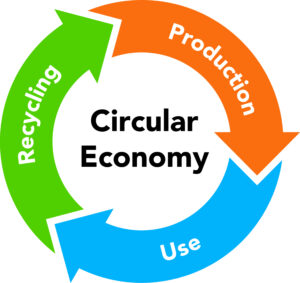SPOTLIGHT ON REFRIGERANT RECOVERY, RECLAMATION AND DESTRUCTION
Avoiding refrigerant emissions and reusing refrigerant, where practical, contributes to the circular economy. Data for reclamation in the EU is incomplete as there is no reporting requirement under the F-gas Regulation for companies that undertake reclamation but none of the reportable activities such as production, import or export. Furthermore, companies reporting on destruction cannot report on reclamation either. A more complete data would provide an improved understanding of how refrigerant reclamation is contributing to the circular economy.
French trade association applauds longstanding efforts to collect, analyze, recycle and efficiently reclaim refrigerant fluids. Snefcca trade association in its 2020 report on the consumption of HFCs in France states that recovery, recycling and reclamation of HFCs has contributed to an average HFC consumption of 43% in the period 2018-2020, 20% lower than the maximum allowable consumption under the F-gas Regulation. Snefcca praised the efforts of the whole sector for a pioneering approach put in place for 27 years to collect, analyze, recycle and efficiently reclaim refrigerant fluids. This voluntary and responsible approach, in the form of a circular economy, initiated in the early 1990s, has prevented the emission of 45 million tonnes of CO2 equivalent in 15 years, the equivalent of one year of emissions from the French car fleet. This year again, the availability of recovery cylinders to operators has increased, allowing to capitalize on the good practices of the players in the sector. See Snefcca website for press release ‘F-gas: encouraging results from a committed profession’, also reported in LaRPF. The Snefcca, the National Union of Cold Enterprises, Professional Kitchen Equipment and Air Conditioning, brings together and unites more than 1,100 companies in the sector.
Store group and equipment supplier work together to reuse reclaimed refrigerant: By reclaiming HFC refrigerant recovered from refurbished stores and using it in newly built stores the store group makes progress towards a circular economy for refrigerants. At the same time the store group is replacing its combustion heating systems with low-carbon heat pumps. The partnership has reused 312.27 kg of refrigerant in 15 European stores, and due to its success, the collaboration is being expanded. The store group excited to intensify activities to include more stores in this program in the coming years and create a closed circle of refrigerant use. The quantity of recovered refrigerant from the stores is certified to match the quantity of refrigerant used in new stores. In this way, both the quality and quantity of the reclaimed refrigerant used in the stores is assured. See refrigeration industry news.
EEA F-gas report acknowledges that data for HFC reclamation in the EU is incomplete: Reported reclamation of HFCs increased each year from 2014 to 2018, from 377 tonnes to 1829 tonnes. In 2019, the reported reclamation amount decreased by about 20 % compared with 2018. The 2019 decrease can be largely explained by the fact that one single gas importer stopped including their reported data amounts reclaimed by an independent sub-contractor. Reclaimed HFCs as reported now make up 8 % of the produced amount, or 3 % of the EU supply of virgin HFCs (or 9 % and 4 %, respectively, as CO2e). see EEA Report No 15/2020, Fluorinated greenhouse gases 2020.
Polyurethane foam waste reused in construction materials extending lifecycle: The European LIFE- REPOLYUSE project developed a new construction material based on the reuse of polyurethane waste, which is deposited in landfills at a rate of around 800,000 tonnes per year. The aim of the project is to increase the sustainable reuse of polyurethane foam waste. Through the new technology, polyurethane foam waste is integrated into new building materials, thus extending their life cycle. Some of the polyurethane foam waste used in the project comes from the refrigeration sector (following degassing of a polyurethane refrigerator insulator) and from the automotive sector and the treatment of end-of-life vehicles. See LIFE-REPOLYUSE website for more information. Note: as the PU waste is reduced to a powder as part of the process, foam that contained fluorocarbon blowing agents would result in emissions unless a contained system is used.
For more information on recovery recycle and destruction see the November 2020 newsletter spotlight.

Image: ©Shutterstock/Cefic